- Clone
- P67.6 (See other available formats)
- Regulatory Status
- RUO
- Other Names
- Siglec-3, gp67, p67
- Isotype
- Mouse IgG1, κ
- Ave. Rating
- Submit a Review
- Product Citations
- publications
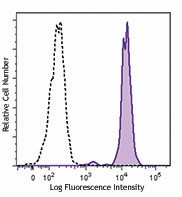
-

Human peripheral blood monocytes were stained with CD33 (clone P67.6) PE (filled histogram) or mouse IgG1, κ PE (open histogram).
| Cat # | Size | Price | Quantity Check Availability | Save | ||
|---|---|---|---|---|---|---|
| 366607 | 25 tests | 117 CHF | ||||
| 366608 | 100 tests | 262 CHF | ||||
CD33, also known as Siglec-3, gp67, and p67, is a 67 kD type I transmembrane glycoprotein. It is a sialoadhesion immunoglobulin superfamily member, which is expressed on myeloid progenitors, monocytes, granulocytes, dendritic cells, and mast cells. CD33 is absent on normal platelets, lymphocytes, erythrocytes, and hematopoietic stem cells. CD33 functions as a sialic acid-dependent cell adhesion molecule with carbohydrate/lectin binding activity.
Product DetailsProduct Details
- Verified Reactivity
- Human
- Antibody Type
- Monoclonal
- Host Species
- Mouse
- Immunogen
- FMY9S5 cells expressing CD33 gene.
- Formulation
- Phosphate-buffered solution, pH 7.2, containing 0.09% sodium azide and BSA (origin USA)
- Preparation
- The antibody was purified by affinity chromatography and conjugated with PE under optimal conditions.
- Concentration
- Lot-specific (to obtain lot-specific concentration and expiration, please enter the lot number in our Certificate of Analysis online tool.)
- Storage & Handling
- The antibody solution should be stored undiluted between 2°C and 8°C, and protected from prolonged exposure to light. Do not freeze.
- Application
-
FC - Quality tested
- Recommended Usage
-
Each lot of this antibody is quality control tested by immunofluorescent staining with flow cytometric analysis. For flow cytometric staining, the suggested use of this reagent is 5 µl per million cells in 100 µl staining volume or 5 µl per 100 µl of whole blood.
- Excitation Laser
-
Blue Laser (488 nm)
Green Laser (532 nm)/Yellow-Green Laser (561 nm)
-
Application References
(PubMed link indicates BioLegend citation) -
- Hoyer J, et al. 2008. Am. J. Clin. Pathol. 129:316.
- Product Citations
-
- RRID
-
AB_2566106 (BioLegend Cat. No. 366607)
AB_2566106 (BioLegend Cat. No. 366608)
Antigen Details
- Structure
- Ig superfamily, sialoadhesins, type I glycoprotein, 67 kD
- Distribution
-
Myeloid progenitor, monocytes, granulocytes, dendritic cells, and mast cells.
- Function
- Adhesion and lectin binding activity.
- Ligand/Receptor
- Sugar chains containing sialic acid.
- Cell Type
- Dendritic cells, Granulocytes, Hematopoietic stem and progenitors, Mast cells, Monocytes
- Biology Area
- Cell Biology, Immunology, Neuroinflammation, Neuroscience
- Molecular Family
- CD Molecules, Siglec Molecules
- Antigen References
-
1. Favaloro E, et al. 1988. Br. J. Haematol. 69:163.
2. Freeman S, et al. 1995. Blood 85:2005. - Gene ID
- 945 View all products for this Gene ID
- Specificity (DOES NOT SHOW ON TDS):
- CD33
- Specificity Alt (DOES NOT SHOW ON TDS):
- CD33
- App Abbreviation (DOES NOT SHOW ON TDS):
- FC
- UniProt
- View information about CD33 on UniProt.org
Related FAQs
- What type of PE do you use in your conjugates?
- We use R-PE in our conjugates.
Other Formats
View All CD33 Reagents Request Custom ConjugationCustomers Also Purchased
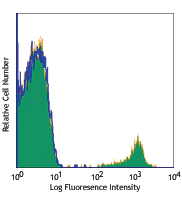
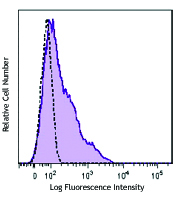
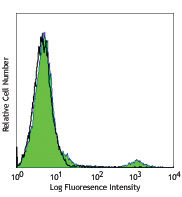

Compare Data Across All Formats
This data display is provided for general comparisons between formats.
Your actual data may vary due to variations in samples, target cells, instruments and their settings, staining conditions, and other factors.
If you need assistance with selecting the best format contact our expert technical support team.
-
Purified anti-human CD33
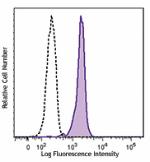
Human peripheral blood monocytes were stained with purified ... -
Purified anti-CD33
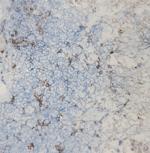
IHC staining of purified anti-CD33 antibody (clone P67.6) on... -
APC anti-human CD33

Human peripheral blood monocytes were stained with CD14 PE a... 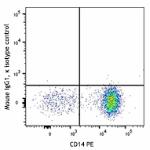
-
PE anti-human CD33
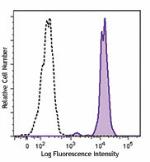
Human peripheral blood monocytes were stained with CD33 (clo... -
Brilliant Violet 510™ anti-human CD33
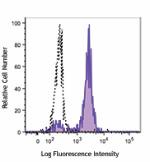
Human peripheral blood monocytes were stained with CD33 (clo... -
Brilliant Violet 605™ anti-human CD33
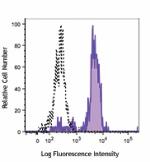
Human peripheral blood monocytes were stained with CD33 (clo... -
APC/Cyanine7 anti-human CD33
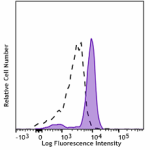
Human peripheral blood monocytes were stained with CD33 (clo... -
PerCP/Cyanine5.5 anti-human CD33

Human peripheral blood monocytes were stained with CD33 (clo... -
PE/Cyanine7 anti-human CD33
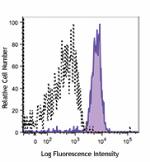
Human peripheral blood monocytes were stained with CD33 (clo... -
FITC anti-human CD33
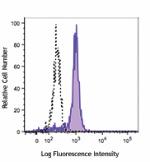
Human peripheral blood monocytes were stained with CD33 (clo... -
Brilliant Violet 421™ anti-human CD33

Human peripheral blood monocytes were stained with CD14 PE a... 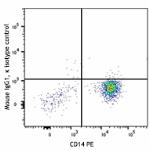
-
Biotin anti-human CD33
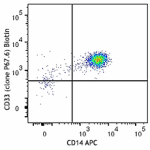
Human peripheral blood monocytes were stained with CD14 APC ... 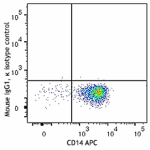
-
Alexa Fluor® 647 anti-human CD33
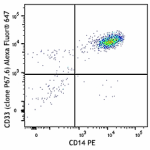
Human peripheral blood monocytes were stained with CD14 PE a... 
-
Brilliant Violet 711™ anti-human CD33
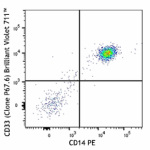
Human peripheral blood monocytes were stained with CD14 PE a... 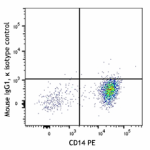
-
TotalSeq™-A0052 anti-human CD33
-
APC/Fire™ 750 anti-human CD33

Human peripheral blood monocytes were stained with True-Stai... -
TotalSeq™-C0052 anti-human CD33
-
TotalSeq™-B0052 anti-human CD33
-
TotalSeq™-D0052 anti-human CD33
-
Spark YG™ 581 anti-human CD33

Human peripheral blood monocytes were stained with anti-huma... -
Spark Violet™ 423 anti-human CD33

Human peripheral blood monocytes were stained with anti-huma... -
Spark Blue™ 574 anti-human CD33

Human peripheral blood monocytes were stained with anti-huma... -
Spark Red™ 718 anti-human CD33 (Flexi-Fluor™)
-
Spark Blue™ 550 anti-human CD33 (Flexi-Fluor™)
 Login / Register
Login / Register 













Follow Us